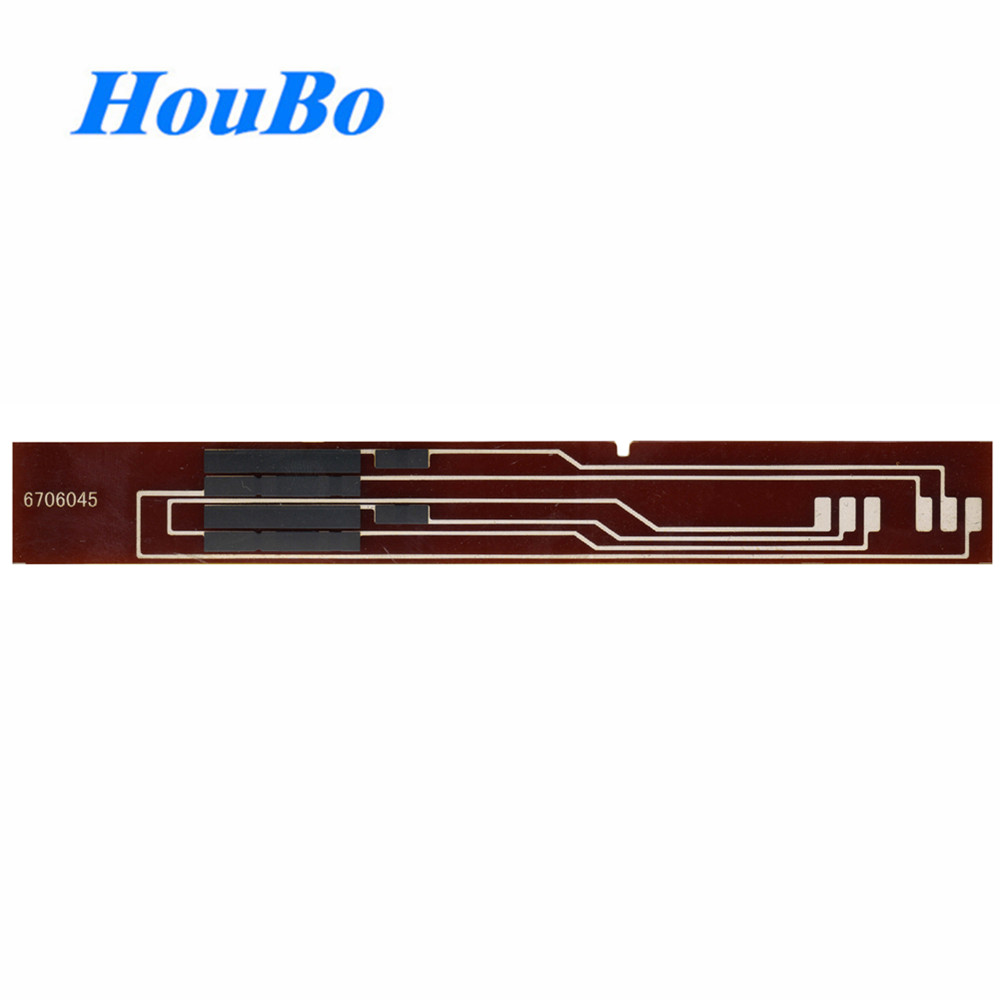-
Free consultation hotline
13925432838
13380289778
Address:
Building 1, Qingtang Avenue, Xinnong community, Danzao Town, Foshan City, Guangdong Province, China
Zip:528226
Company Name:Foshan Nanhai Houbo Electronic Technology Co., Ltd.
Operational Address:Liu Yingxiang Workshop II, Xinnongqingtang Development Zone, Danzao Town, Foshan, Guangdong, China
Industry News
Your current location is:Home> News> Industry NewsWhat are the common types of automotive sensors pcb
In order to ensure the normal operation of the car, people in the car operation of various conditions of information, such as speed, various media temperature, engine operating conditions, etc., into electrical signals to the car controller (such as computers, etc.), so that the engine in the best working condition, these signals are collectively referred to as automotive sensors. One of the characteristics of modern automotive technology development is that more and more components using electronic control.
The role of automotive sensors is very large, once a sensor failure, the corresponding device will not work properly or even do not work. In the past, automotive sensors were simply used on the engine, but now they have been extended to the chassis, body and lighting electrical system, including automotive sensors that measure temperature, pressure, flow, position, gas concentration, speed, light brightness, dry humidity, distance, etc.
Speed Sensor
Figure 1 shows a traditional speedometer, which is mechanical in nature. A typical mechanical odometer is connected to a flexible shaft with a wire cable inside, and the other end of the flexible shaft is connected to one of the gears of the transmission. The rotation of the gear drives the rotation of the wire cable, which drives the rotation of a magnet in the odometer cover ring, and the cover ring is connected to the pointer and the pointer is placed at the zero position through the balance wire.
The unit of tachometer is 1/min×1000, which shows how many thousand revolutions per minute the engine turns. Tachometer can visually display the engine speed in various operating conditions, the driver can always know the operation of the engine, with the transmission gear and throttle position, so as to maintain the best working condition, to reduce fuel consumption, extend the life of the engine is good.
In addition to mechanical tachometers, there are now more electronic tachometers, both pointer type and LCD digital display type, with digital integrated circuits inside the meter, which drive the pointer movement or digital display after calculating the voltage pulse delivered from the ignition coil.
There is another type of tachometer that gets a pulse signal from the generator to the tachometer circuit and then displays the speed value, but the value is less accurate due to factors such as generator belt slippage
Throttle position sensor
The throttle position sensor is mounted on the throttle and is used to detect the opening of the throttle. It is linked to the throttle through a lever mechanism, which in turn reflects the different operating conditions of the engine. This sensor can detect the different working conditions of the engine and input to the electronic control unit (ECU), so as to control the different fuel injection amount. It has three types: switch contact throttle position sensor (Santana 2000 car and Tianjin Sanfeng bus), linear variable resistance throttle position sensor (Beijing Cherokee), integrated throttle position sensor (domestic Audi 100 type V6 engine).

Crankshaft position sensor, also known as crankshaft angle sensor, is the most important sensor in the computer-controlled ignition system, its role is to detect the upper stop signal, crankshaft angle signal and engine speed signal, and its input into the computer, so that the computer can issue the best ignition moment command according to the ignition sequence of the cylinder. Crankshaft position sensor has three types: electromagnetic pulse crankshaft position sensor, Hall effect crankshaft position sensor (Santana 2000 type sedan and Beijing Cherokee), photoelectric effect crankshaft position sensor. Crankshaft position sensor type is different, its control mode and control accuracy is also different. The crankshaft position sensor is generally installed on the side of the crankshaft pulley or sprocket, some are installed on the front of the camshaft, and some are installed on the distributor (Santana 2000 sedan).
Temperature Sensor
Temperature sensors are mainly used to detect engine temperature, intake gas temperature, cooling water temperature, fuel temperature, and catalytic temperature. There are three main types of temperature sensors: wire-wound resistive, thermistor and thermocouple resistive. Each of the three types of sensors has its own characteristics, and their applications are slightly different. Wire-wound resistance type temperature sensor has high accuracy but poor response characteristics; thermistor type temperature sensor has high sensitivity and good response characteristics, but poor linearity and low temperature adaptation; thermocouple resistance type temperature sensor has high accuracy and wide measurement temperature range, but it needs to be used together with amplifier and cold end processing.
The water temperature sensor shown in Figure 3, for example, its internal is a semiconductor thermistor, the lower the temperature, the greater the resistance; vice versa, the smaller the resistance, installed in the engine block or cylinder head of the water jacket, direct contact with the cooling water, so as to measure the temperature of the engine cooling water. Electronic control unit according to this change in the temperature of the engine cooling water, the lower the temperature, the greater the resistance; and vice versa, the smaller the resistance. According to this change, the electronic control unit measured the temperature of the engine cooling water, as a correction signal for fuel injection and ignition timing. Simply put, the user can use the temperature of the engine water temperature to understand the current running state of the car, stop or movement, or how long the movement time, etc.
In addition to the above resistive temperature sensors, automotive electronics are widely used in the bimetal type temperature sensor. Bimetal type temperature sensor is a kind of temperature sensor made by using the temperature characteristics of bimetal, such as cold start timing switch, which consists of housing, bimetal, heating coil, contacts, etc.
The cold start timing switch is a "temperature and time" switch that is threaded into the engine water outlet to detect the engine water temperature. This switch has an internal normally closed contact with a movable arm made of bimetal. The bimetal is made of two pieces of metal with different coefficients of thermal expansion bonded together, with the change of temperature, the two metal pieces produce thermal expansion difference, the temperature is low, the bimetal keeps the original state; when the temperature rises to a certain level, the bimetal bends to the side of the metal piece with low expansion coefficient. Around the bimetal is wound with two heating coils, heating can make the bimetal bend, so that the contact is broken. Engine warming to a certain temperature, the original closed contacts should be open state.
When the engine is cold, the timing switch contact is closed. When cold starting, the ignition switch is in the starting position and current flows through the starting power end. The current flows from the battery through the ignition switch, cold start injector, bimetal of the timing switch, contact and ground to form a circuit, which makes the cold start injector spray oil. At the same time, there is also current flowing through the heating coil of the timing switch, and the two heating coils make the bimetal heated, and when it bends and breaks the contact, the cold start injector stops spraying oil.
After starting, the starter switch is disconnected and the ignition switch is turned from the starting position to the disconnected position, no current flows through the cold start injector to stop it from injecting fuel. At the same time, the two heating coils are disconnected, but at this time the engine has been in a warm state, the water temperature rises enough to bend the bimetal, the contacts are disconnected, that is, the engine is running normally, the contacts of the cold start injector timing switch remains disconnected, the cold start injector does not spray oil.
Automobile manufacturers have specified the operating temperature of the cold start injector timing switch according to their own design, such as below 18℃ for Nissan series and below 35℃ for Toyota series. The lower the water temperature, the longer the cold start injector operating time. Cold start injector injection time depends on the length of time the injection valve is open.
Pressure sensors are mainly used to detect negative cylinder pressure, atmospheric pressure, turbo engine boost ratio, cylinder internal pressure, oil pressure, etc. Suction negative pressure type sensor is mainly used for suction pressure, negative pressure, oil pressure detection. Automotive pressure sensor applications are more capacitive, piezoresistive, differential transformer type (LVDT), surface elastic wave type (SAW). Capacitive pressure sensor is mainly used to detect negative pressure, hydraulic pressure, air pressure, measuring range 20 ~ 100kPa, with high input energy, good dynamic response characteristics, good environmental adaptability; piezoresistive pressure sensor is affected by temperature, need to set up another temperature compensation circuit, but adapt to mass production; LVDT type pressure sensor has a large output, easy digital output, but poor anti-interference; SAW type pressure sensor has the characteristics of small size, light weight, low power consumption, high reliability, high sensitivity, high resolution, digital output, etc. It is used for automotive suction valve pressure detection, and can work stably at high temperature, which is a more ideal sensor.
Oil pressure sensors are miniature mechatronic systems that integrate micro sensors, actuators, and signal processing and control circuits, interface circuits, communications and power supplies. Commonly used are silicon piezoresistive and silicon capacitive, both of which are micromechanical electronic sensors generated on silicon wafers. In general, users use the oil pressure sensor to detect how much gasoline is left in the car's oil tank and convert the detected signal into a signal we can understand to remind how much gasoline is left, or how far it can go, or even to remind the car that it needs to be filled with gasoline.
Air Flow Sensor
The air flow sensor converts the inhaled air into an electrical signal and sends it to the electronic control unit (ECU) as one of the basic signals to determine fuel injection. According to different measurement principles, can be divided into rotary wing air flow sensor (Toyota PREVIA station wagon), Kamen vortex air flow sensor (Toyota Lexus LS400 car), hot-wire air flow sensor (Nissan Qianli Ma with VG30E engine and domestic Tianjin Sanfeng bus TJ6481AQ4 with Volvo B230F engine) and hot film air flow sensor Four types of flow sensors. The first two for the volume flow type, the latter two for the mass flow type. At present, the main use of hot-wire air flow sensor and hot film air flow sensor two.
Intake pressure sensor
Intake pressure sensor can measure the absolute pressure in the intake manifold according to the load state of the engine, and converted into an electrical signal and speed signal together into the computer, as the basis for deciding the basic injector injection volume. Domestic Audi 100-type car (V6 engine), Santana 2000-type car, Beijing Cherokee (25L engine), Toyota Crown 3.0 car, etc. are used in this pressure sensor. Currently widely used is the semiconductor varistor type intake pressure sensor.
Shock Sensor
The detonation sensor is mounted on the engine block to monitor the detonation of the engine at any time. There are two main types of resonant and non-resonant types currently used.

pcb series:Ceramic circuit board | Fuel sender PCB | Printed Resistors PCB | Throttle Position Sensor PCB
Copyright © 2018 Foshan Nanhai Houbo Electronic Technology Co., Ltd.





 中文站
中文站
 English
English